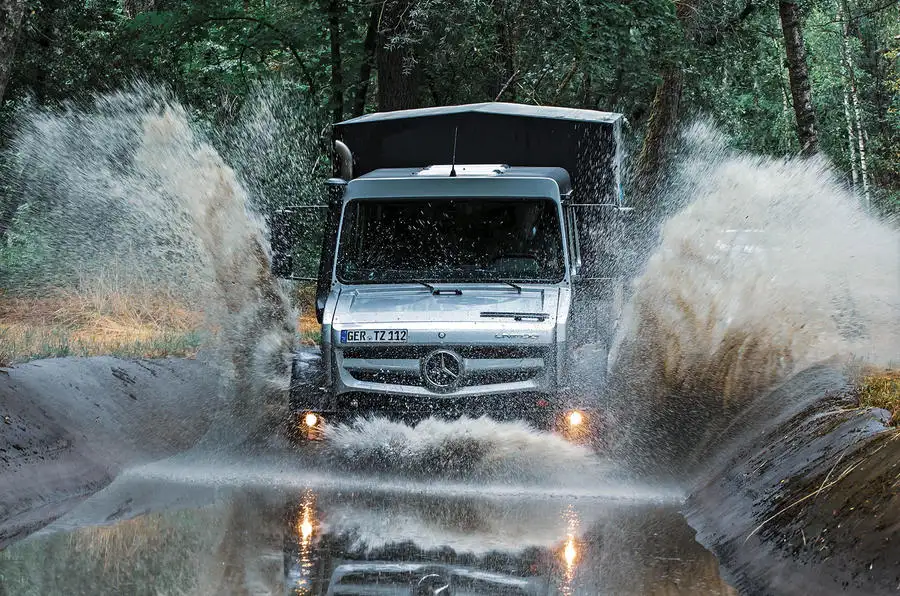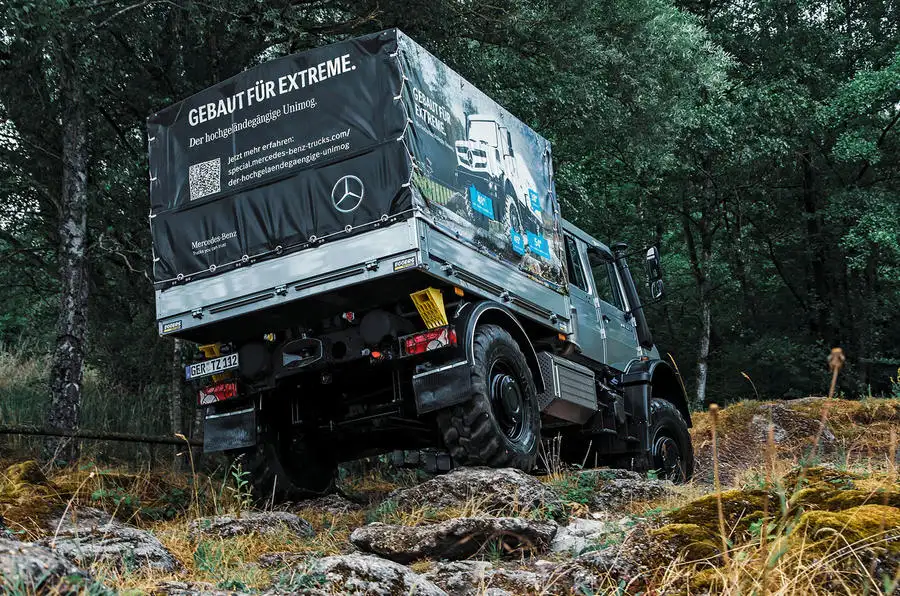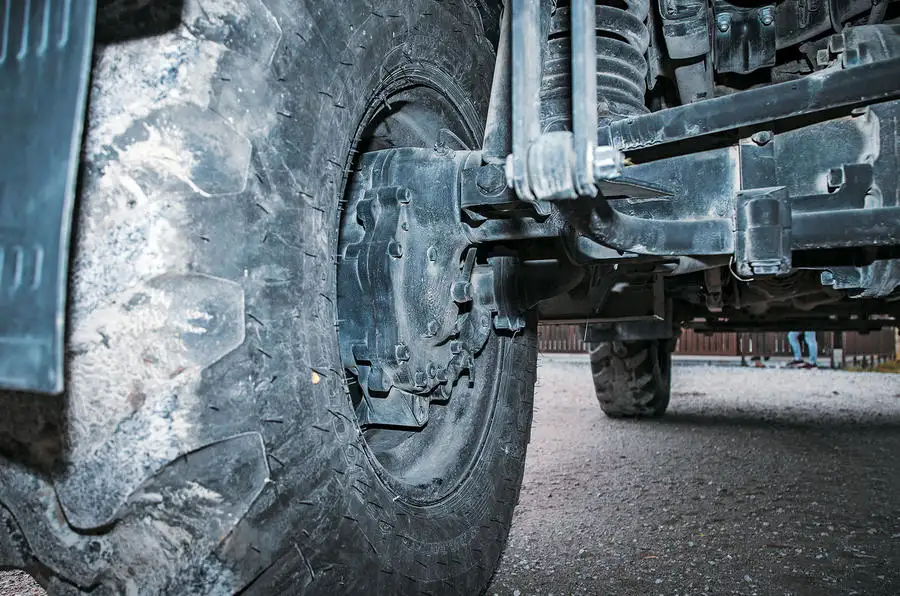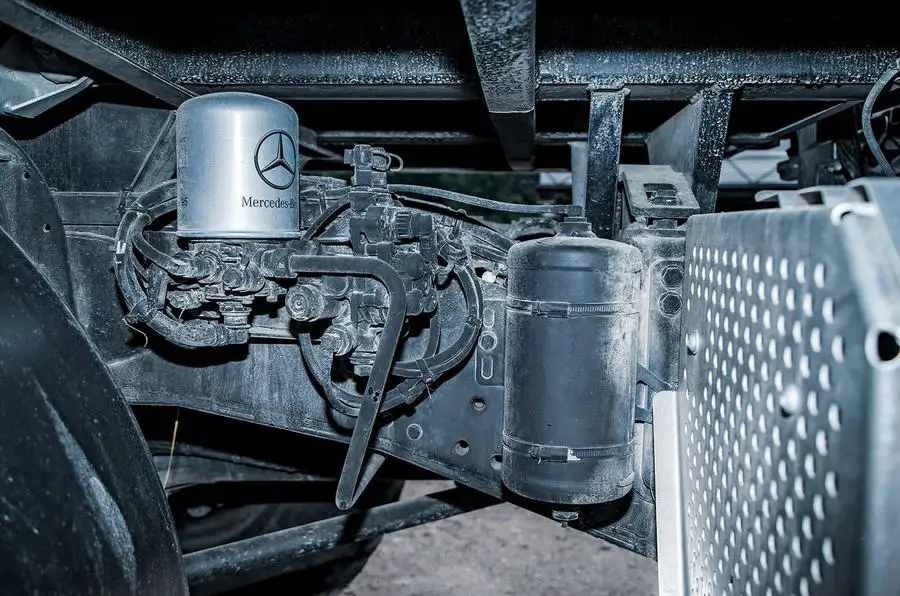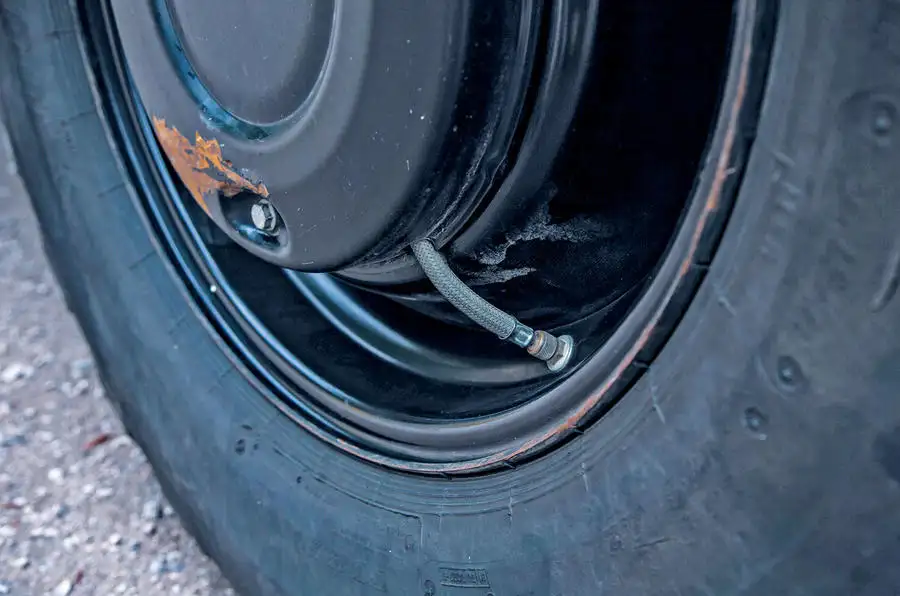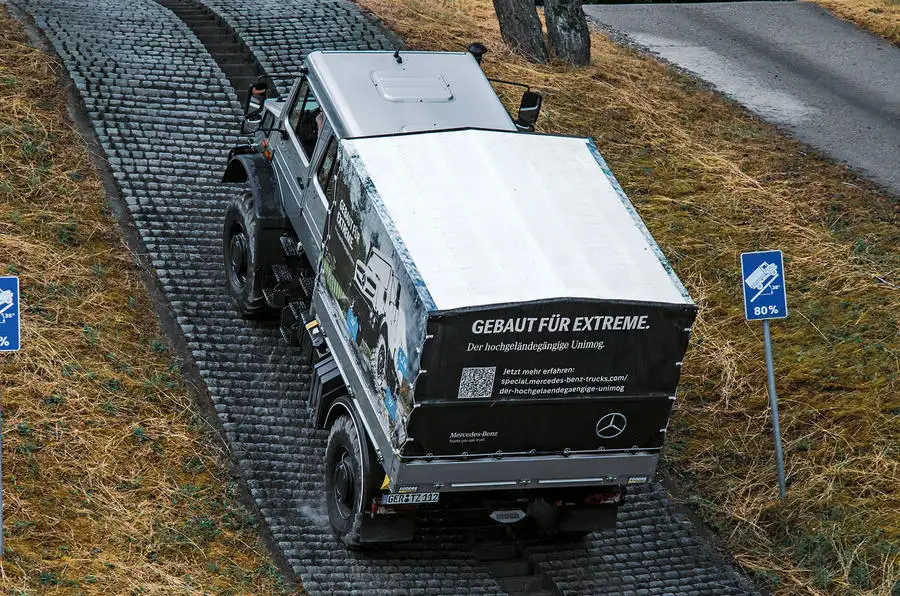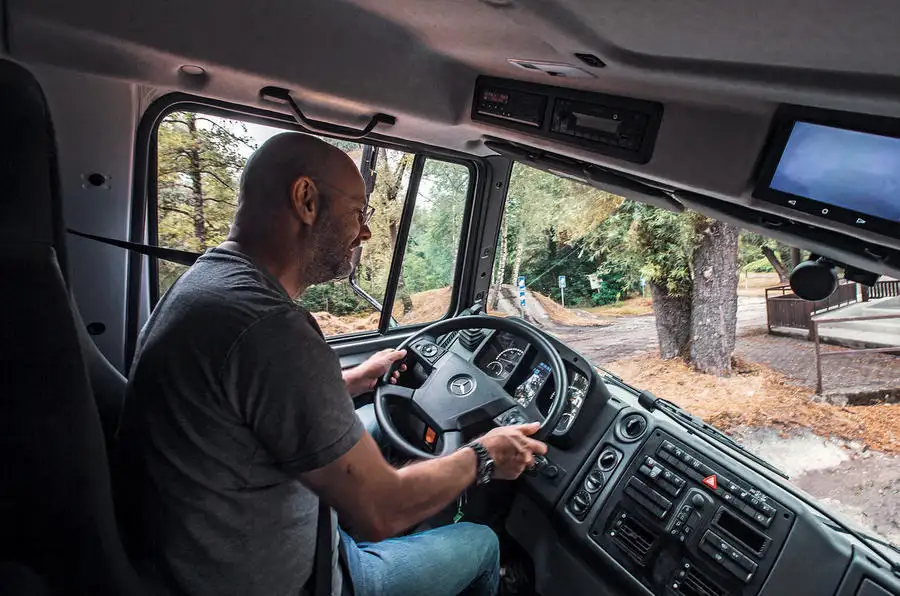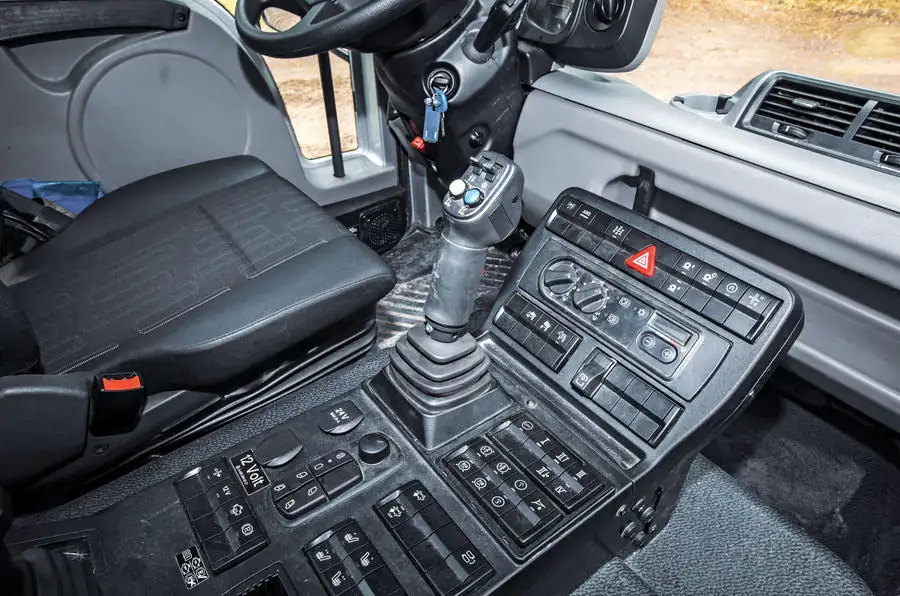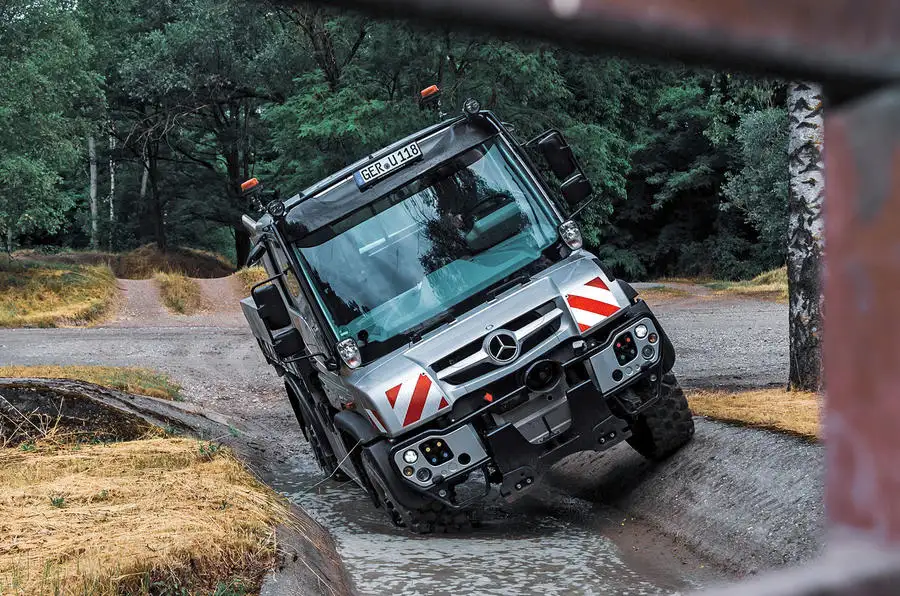A Unimog is a Swiss Army knife on wheels: fit for any purpose.
Chances are you will know a bit about the Mercedes-Benz Unimog but, unless you’re a Moggite, not everything. And even then, probably not everything everything, because there’s such a lot to digest.
In a good 4×4, I would by now have flooded the engine, grounded the chassis, burnt through several clutches and remodelled the bodywork. I would, in short, be walking home, possibly with a limp and certainly with wet trainers. But not today, because I’m driving a Mercedes Unimog.
Now in its 75th year, Unimog, part of Daimler Truck (which has Mercedes-Benz, Freightliner and other brands in the mix), on the surface makes two model lines: the UGE implement carrier and the UHE extreme off-roader. Here, I’m driving a UHE. But like Mercedes-Benz’s car model line-up, it’s more complicated than that.
The UGE implement carrier has 17 different factory-fresh variants across six wheelbases, with five power outputs via engines of four or six cylinders, even before you send it to a specialist for any customisation.
This UHE is more straightforward, with only one wheelbase and length to worry about, one engine option and two cab styles (including pick-up variants). It’s 6.0m long, 2.5m wide and 2.9m tall. But there are still two variants, one being more heavy-duty than the other, owing to beefier axles. Those take its maximum permissible weight from 10.3 tonnes to 14.5 tonnes.
Pictured here is the heaviest-duty double-cab variant of the UHE, the 5023 Crew Cab, which makes it the king of off-road Mercedes Unimogs and therefore probably a king or at least a notable prince among off-roaders, able to go farther into the rough than most of the planet’s other wheeled vehicles; and certainly farther than any vehicle that’s also a truck so can do 85km/h on the road.
Not for nothing has it been named Off-Road magazine’s vehicle of the year for the past 18 years running. Duality of purpose is really at the heart of every Unimog, from the very first of 1948 to a vehicle sufficiently popular today that Daimler makes more than 2000 a year.
In the mid-1940s, a tractor was a farmer’s lot. Two-wheel drive and with an exposed and uncomfortable seat situated over the rear axle, they were rugged but slow, and if you wanted to carry anything, you needed a trailer too. German engineer Albert Friedrich’s original Unimog ‘70200’ tore up that rulebook.
He made room for two occupants, side by side, above and behind the engine, protected by a windscreen and a canvas hood. He gave his machine four-wheel drive and portal axles – gears at each wheel, which push the axles higher than the wheel centres, for improved ground clearance.
Its track width was the size of two rows of potatoes so could be driven into fields, it could tow and it had a power coupling for farming equipment. But there was also a load bed on the back and, with 19kW, even the first Unimogs could reach 50km/h on the road – a speed that no tractor of the day could imagine.
The principles employed by Friedrich hold true today. The modern Unimog has a longitudinal engine up front, driving a 4WD system that uses portal axles just as the original did and locates its prop and half shafts within tubes to protect them from rock strikes and grime.
Things have become more sophisticated since, and bigger, inevitably. Today, a Unimog has eight forward gears and up to eight reverse gears. It has three locking differentials, front, centre and rear, with any hydraulic lines or electric cables running above the axle tubes, isolating them from damage too.
That the portal axle alters the gearing means that the differentials, offset from centre, can be smaller than if they were running at road wheel speeds, further improving ground clearance, which runs at 480mm – about twice the amount of a Jeep Wrangler.
And then there’s the chassis flex. This has been designed into the Mog’s chassis from a relatively early juncture. Two longitudinal chassis rails, curved, are connected by torque tubes that allow the chassis to flex from front to back, increasing wheel articulation and keeping the tyres on the ground for longer.
As a result, the cab and whatever box or bay or tool is loaded on the back are mounted centrally, so that they don’t flex while the chassis does beneath them.
This load stability is essential if there’s, say, 4000 litres of water back there, because the Unimog is popular with rural fire services. Some use 40-year-old examples and don’t necessarily want to change them: 80% of Unimogs are still in service. But, as one of the company’s engineers tells us, “40 years is 40 years”. Vehicles wear out.
A new machine is much more capable than an old one and, with a central tyre-pressure system that can inflate or deflate individual tyres from inside the cabin, a Unimog could suffer a puncture in a dangerous place and still be driven away from danger, other tyres having been adjusted to compensate.
It also means that overland campers can level the body if they’re parked on a slope but want a flat night’s sleep. On the road, a UHE will run its tyres at 5-6 bar of pressure, with them as low as 1.5 bar on soft ground, where it can wade through water safely at 1.2m deep – and even if that turns out to be deeper, “it’s not a disaster”. The important numbers are 44deg for the approach angle, 50deg for the departure angle and 31deg for the breakover angle. It can climb up a 45deg slope and won’t tip onto its side until past 38deg laterally.
The twin-turbocharged 5.1-litre four-cylinder diesel engine is mounted high and the cabin of the UHE is largely above it, so it’s a big clamber into the cockpit. The steel cab’s design has gone largely unchanged since the 1990s, even though the vehicle has been updated, so that’s why it looks like it has been around for a while. Big metal press moulds are too expensive to redesign for such modest production volumes. The smaller, more modern-looking UGE implement carrier has a composite body built using cheaper moulds.
Still, the UHE’s cabin is airy, and visibility is pretty good over its sloping bonnet. There are three broad seats in the front, the side ones each separately sprung but the centre one uncomfortably sited on a transmission hump, plus four in the rear of the cab. Mirrors show the body sides easily and there’s a generous array of cameras, which can be magnetically mounted to the chassis so you can aim them where you want.
A big steering wheel sits almost flat in front of the driver and there’s a typical Mercedes column stalk that handles indicators and wipers. A fat stalk on the right handles the gears and the pedals are big.
This is a big vehicle, but its controls are a doddle to use, as they ought to be, given the stressful situations – near wildfires, near weapons fire – in which its drivers can find themselves. The brake pedal is soft and it’s easy to give the pneumatic disc brakes too much shove.
The throttle is long and response leisurely, but that’s what you need off road too: the ability to meter out only as much of the 170kW and 900Nm of torque, made from 1100rpm, as you want. Laid-back shifts can be made automatically or, as we’re doing on the off-road course, manually.
Ride comfort, even on rough ground, is exceptional. With a heavy body, 70-profile tyres (455mm wide and on 24in rims) and a suspended seat, that’s maybe not surprising, but there’s a delightfully isolated lope to it. Rolls and dives a bit, obviously.
The steering is slow and light but, being hydraulically assisted, also picks up on resistance from obstructions under the wheels so gives a brilliant impression of what’s going on underfoot. If you hit mud and the wheels turn easily or there’s a rock making them not want to turn, you know about it immediately.
That makes it a very honest and, unlikely as it may sound, particularly rewarding vehicle to drive. It’s possible to thread it with terrific accuracy. Picking a gear to go at a hill or letting it crawl at a gentle idle as it climbs over obstacles you couldn’t walk up is a joy. Even on the steepest descents, you might want a little braking, but the big engine does plenty of its own braking, resting at around 1400rpm, well under its 2500rpm limit.
It’s enough to make me think of a good reason why I would need one, even though a new one will cost more than $350,000. For businesses, the answer is simple: it will do things that no other vehicle can, such as carrying utilities workers or firefighters to otherwise inaccessible places.
For leisure customers, it’s also straightforward: they just want one. Unimog would like a few more of those to smooth out the purchase habits, because some fleets might want none one year, then 20 the next.
Dealers have a configurator, of course. I reckon if you made that publicly available and pointed people to the Unimog museum, they wouldn’t be able to help themselves.




